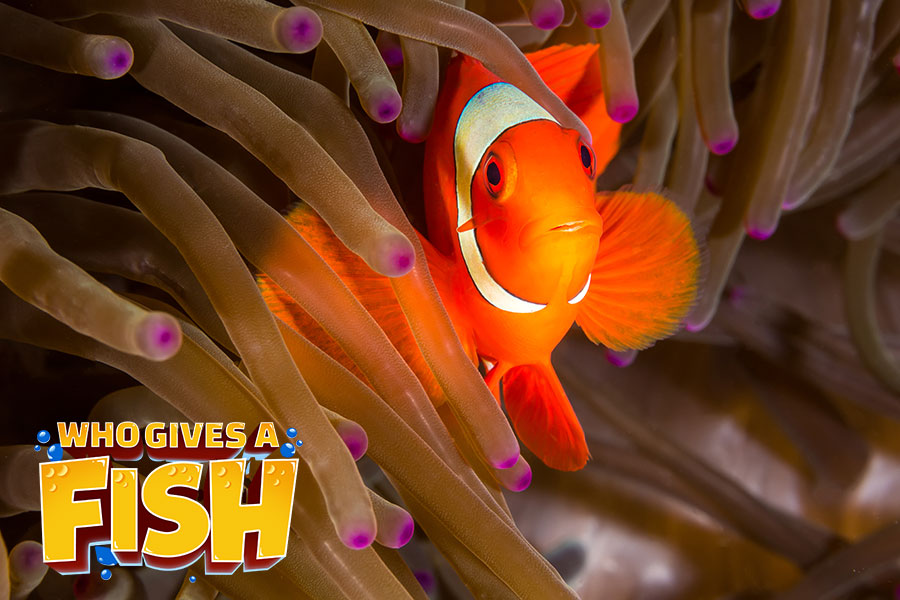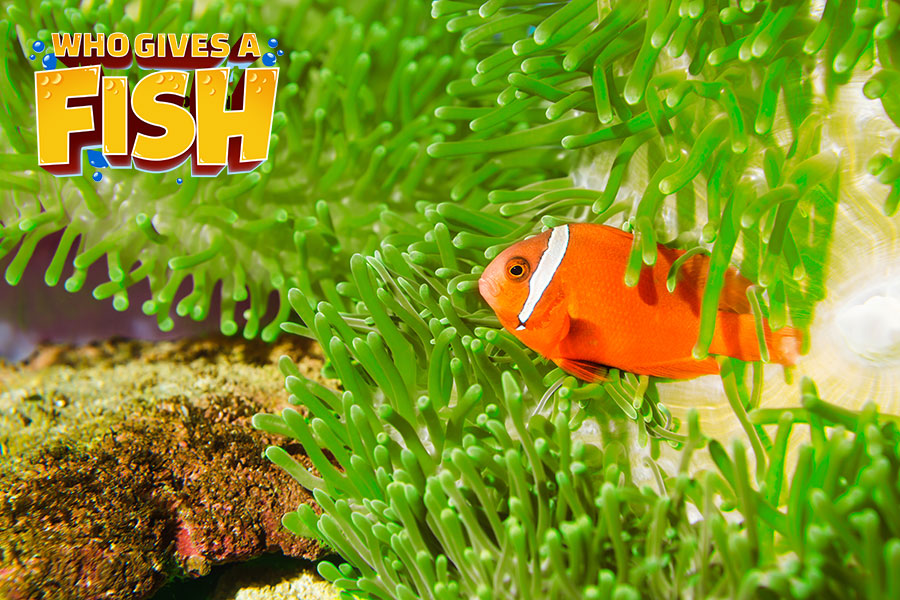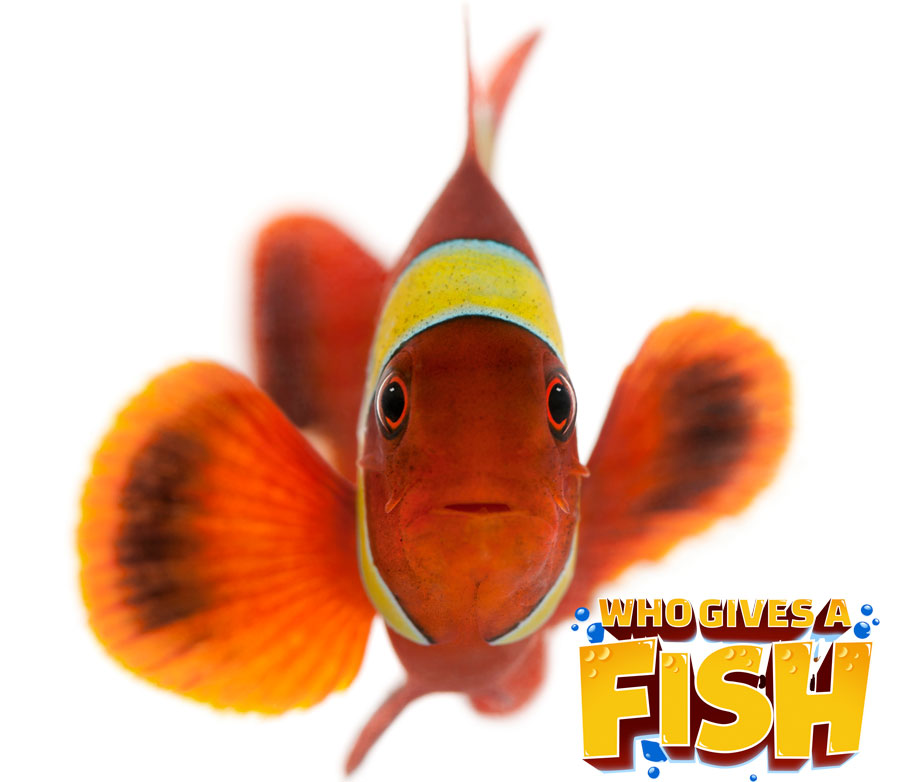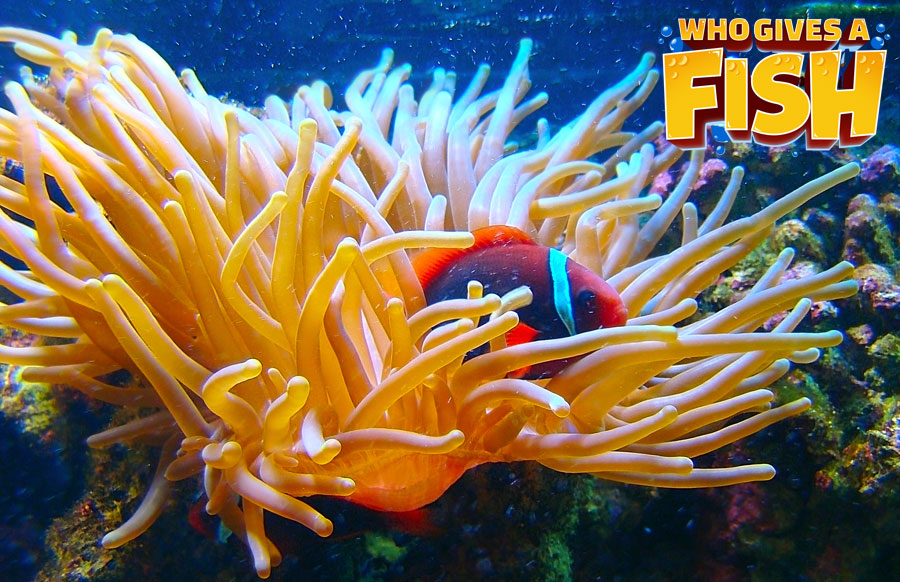Maroon Clownfish
It is difficult to mistake the Maroon Clownfish, Premnas biaculeatus, with any other clownfish species. It has a broad dispersal over the Indo-west Pacific, and into the Indo-Australian Archipelago, however it is a rare specimen, and in a genus of its own.
It can be distinguished from all of the other Clownfish by the spines protruding from its cheeks and a consistent red color. Due to these cheek barbs, Bloch, in 1790, initially portrayed it as Chaetodon biaculeatus.
- Experience Level: Beginner
- Hardiness: Very Hardy
- Minimum Tank Size: 30 gal (114 L)
- Size of fish: 6.3 inches (16 cm)
- Temperament: Aggressive
- Temperature: 74.0 to 82.0° F (23.3 to 27.8° C)
- pH Range: 7.8-8.4
- Diet: Omnivore
Table of Contents
Introduction
Aquarium Setup
Difficulty
Feeding
Breeding
Social
Chaetodon are indeed butterflyfish, and those fish do sport these spines, however this fish is a clownfish. But because of its spines it is also referred to by the common names such as the Spine-Cheek Clownfish and the Spinecheek Anemonefish, as well as the Maroon Anemonefish.
The females of this species are a few of the biggest Clownfish. They are known reach up to 6.3 inches (16 cm) in length. A few accounts suggest they can grow even larger in captivity, up to as much as 8 inches in length. Males, however, are a lot smaller, usually only 1/3 the size of a female, although they can reach just short of 6 inches (13 cm) in length.
These clowns are extremely similar in shape to the Ocellaris Clownfish and True Percula of the Percula Complex. And just like other clownfish, they have numerous color variety’s. They can range from dazzling red, orange or maroon, to a purply brown. They are accentuated with three vertical bands that can be broad or think, and some specimens will be mis-barred. Mis-barred essentially means the bars are only across the top of the body, and do not extend all the way down the sides.
There have been two distinct geographic variants for a long period of time, one with yellowish or golden bars and one with white bars. The golden striped variation originates from Sumatra and perhaps even eastern Java. But a new variation has also been imported as lately as 2012, and it has bands exchanged with a lightning and netting type patterning. It was gathered from New Guinea from Fisherman’s Island, and it has generated quite a stir in the hobby. These sorts are now being selectively spawned in captivity, however they are fairly pricey. Their newly aqua-refined babies are often known as little sparks.
Maroon Clowns are reared in captivity. They are obtainable singly, as well as in couples, however Maroons are generally a bit costlier than most of the other clownfish breeds. Based on their looks, a few of the depictive common names they are referred to as comprise of White Stripe Maroon Clownfish, Yellow stripe Maroon Clownfish and the Gold Stripe Maroon Clownfish, on top of the two designer names of Orange Jaw Purple Maroon Clownfish and Lightning Maroon Clownfish.
This is an excellent fish for the amateur, as it is extremely rugged, but it can get rather big and is known to be very territorial. It is one of only a few clowns that can hold its own in a hostile tank. It makes an exciting character in the aquarium setting, but is so hostile that it’s hard to house, even with other damsels. Females have been noted to hurry to the front of the tank and thrash their pectoral fins about in order to caution visitors of their fearless and savage nature, even picking up and spitting pieces of gravel or rocks.
Maroon Clownfish should not be housed with tame fish such as dartfish, gobies, etc. and they will kill other clownfish. Be ready to take away other fish from the tank, as a Maroon Clownfish may choose one day that a specific fish needs to go!
They are ideal for a hostile tank setting. This is a particular fish that thrives with more warlike fish such as large angelfish and triggers, just ensure to add the clownfish at the start, and provide it time to settle in. These clownfish are simple to house with bigger semi-hostile fish and smaller hostile fish such as line wrasses, as well as a few eels. Large Anthias may hold their own with this clown, and dwarf angelfish who are more aggressive may also hold their own in a larger tank. Still, keep an eye on these fish to make sure they are not being attacked.
These fish are as durable as they are mean! Provide at least 30 gallons for one Maroon Clownfish, and 55 gallons for a pair. Like all saltwater fish good water quality helps keep them healthy. They are harder to pair up as a male and female, compared to other clownfish. These females are much more picky about their mates, to the point of killing an unacceptable mate. Once a mate is accepted, the female will defend it to the end. The female is the dominant fish and can be moody. A lot of rock work to hide in or a large anemone is needed for the male to retreat into, when the female’s aggressive nature comes out. They tend to stay where they have adopted an anemone, coral, or other substitute host, but may swim at all levels of the aquarium at times. As they are not the most agile swimmers, so water movement should not be swift in the area the clown has adopted.
Striking contrasts in a home aquarium – Premnas Biaculeatus
Aquarium Setup
The Maroon Clownfish is one of the largest clownfish, and is quite active. It needs a minimum tank size of 30 (114 L) gallons for a single specimen, and 55 gallons minimum for a pair. Keep in mind smaller tank sizes result in water quality degrading quicker, thus requiring 5% water changes every week. Although they are tolerant of less than perfect water quality, prolonged poor water quality will result in illness and disease with any saltwater fish.
Live rock with plenty of hiding places and for them to forage from is appreciated. This clown will appreciate a host anemone or an other invertebrate or rock structure to adopt as a substitute host. If keeping within an anemone, the tank should be sized according to the anemones needs. With an anemone it will need to have adequate lighting and the tank should be well established, meaning 6 months to a year old. They will spend the majority of their time with a host, but will also swim in all parts of the aquarium. Water movement is not a significant factor, but it needs a slow circulation in some areas of the tank to feed.
This species lives in tropical areas, so maintain aquarium water temperatures between 74°F to 82°F (23 – 28°C), and they can tolerate a pH range from 7.8 to 8.4. Keeping the tank at 82° F (28°C) seems to keep them healthier and entices them to eat more. Extremes above 90° F (32° C) or below 64° F (18° C) would be beyond their tolerance. Optimum spawning occurs between 79°F to 83°F (26°C to 28°C).
Maroon Clownfish Aquarium Guide
- Minimum Tank Size: 30 gal (114 L) – A minimum of 30 gallons is required for a single fish, with 55 gallons plus for a pair. If keeping with an anemone a larger tank of 55 gallons or more is recommended.
- Suitable for Nano Tank: Definitely Not
- Live Rock Requirement: Rock structures with ample hiding places are important, especially for the male to hide in.
- Substrate Type: Any
- Lighting Needs: Any – They have no special lighting requirements though if kept with a host, the anemone will need its appropriate lighting.
- Temperature: 74.0 to 82.0° F (23.3 to 27.8° C)
- Breeding Temperature: 79.0° F – The optimal temperature for high quality eggs and larvae occurs with temperatures of 79° F to 83° F (26° – 28°C).
- Specific gravity: 1.023-1.025 SG
- pH Range: 7.8-8.4
- Brackish: No
- Water Movement: Any – Provide areas in the tank with calmer waters for feeding and calm water where they rest.
- Water Region: All – If they have a hosting anemone or coral they will often stay in the same vicinity. They will stray from their host anemone to chase other fish including other Maroon Clownfish males.
Difficulty
Maroon Clownfish are hardy and easy to keep as long as water conditions are acceptable. They make a great fish for the beginning aquarist, but they are aggressive which will limit the selection of tank mates. The biggest concern with these fish is if you are keeping a pair. A moody, aggressive female picking on the male will cause a great deal of stress, which can eventually mean a sick fish.
It is recommended when keeping a pair to have a larger tank and provide a large anemone or a lot of rock work with hiding places that the female cannot fit into. For pairing them up, read about social behaviors below. To keep them with an anemone, provide the proper sized tank for that specific anemone, as well as its necessary lighting. A nice thing about keeping an anemone is that due to the protection it affords the clownfish, your choice of tank mates will expand a little more.
Feeding
The Maroon Clownfish are omnivores. In the wild they feed mostly on zooplankton and different types of algae. In the aquarium they will eat a wide variety of live, frozen and flake foods. They will also consume naturally growing algae in the tank.
It is important that you feed a variety of fresh or frozen meaty foods. You can feed them mysis shrimp, brine shrimp, finely chopped fish, and chopped mussels. Their diet should also consist of a variety of vegetable source foods. They will take flake and pellet, but be sure these have spirulina added if there is not enough algae in the tank for them to eat, Feed 3 to 4 times a day as juveniles and 2 to 3 times as adults. Offer a varied diet in smaller amounts, instead of one large feeding. Provide an area in the tank where the water is not too strong, so they can feed easily.
Maroon Clownfish Feeding Guide
- Diet: Omnivore – Use products with Spirulina added if there is not enough algae in the tank
- Flake Food: Yes
- Pellet / Tablet: Yes
- Live foods (fish, shrimp, worms): Varied live food within their diet – while not necessary these can be beneficial to condition them for spawning
- Vegetable Food: 50% of their diet
- Meaty Food: 50% of their diet
- Feeding Frequency: Feed adults twice a day and juveniles 3 to 4 times a day for optimal health
A great video showing the Gold Stripe Maroon Clownfish
Breeding
Males are smaller, reaching about 1/3 the size of the female up to a little over 5”. The females are larger, reaching over 6”. Some have reported having an 8” female, which may be possible in captivity.
The Maroon Clownfish has been bred in captivity. Getting a compatible pairing is the challenge. A Maroon pair will spawn in water temperatures of 79°F to 83°F (26°C to 28°C). Feed nutritious food to enable them to lay healthy eggs. Courtship will start 3 to 5 days before spawning, and during this time the female’s belly starts to swell with eggs.
As they start to get closer to spawning, they vigorously clean an area of rock very close to the anemone, in order for the eggs to adhere correctly. The performance of various rituals such as head standing, touching their ventral surfaces, and/or leaning towards each other with dorsal surfaces touching as they shake their heads now begins.
When the female is ready to lay her eggs she will nip at the anemone so it retracts, now exposing the spawning sight. At this time she will lay her eggs, closely followed by the male who promptly fertilizes them. Spawning is known to occur late morning to early afternoon and can last up to 2 1/2 hours.
A clutch of Maroon Clownfish eggs in the wild number between 146 to 986, with an average being 480. With the above-mentioned water temperature, hatching will happen on the sixth evening after spawning (other clownfish hatch days later). The larvae ascend into the water column, and although the hatch rate is good, survival of the larvae is quite poor when compared to other clownfish species.
Within 8 to 16 days, the larvae that survive not being eaten in the wild, or in captivity ones who survive fungus or other maladies become free swimming young clown fish. Then the search for their anemone for protection and food begins. Two types of recognition of the host anemone occur when these fish are still growing in their eggs. First, there is a scent that the particular anemone emits that they have been laid by, and/or second, the visual recognition of their parents swimming within the tentacles.
In captivity, Maroon Clownfish will lay 1,500 eggs, which hatch around the 7th day. They are able to be sold at 8 to 10 months of age, and the gold striped variation can take up to a year to develop this coloring






Social
The Maroon Clownfish is the most aggressive of all Clownfish. They can be kept in a reef setting or a fish only setting. but they can be very territorial and aggressive. They are aggressive even when attempting to form a male and female pair! Just putting two juveniles together does not always result in a pairing, but may result in death since, unlike other clownfish, they will fight among themselves. An aquarist will have better success by choosing an obvious large female and small male, but watch the aggression from the female so he does not end up bludgeoned to death. Trying a large female and several males would be suggested, but be ready to remove the ones who are not accepted and provide areas for them to hide that the female cannot fit into. Some aquarists put in an egg crate divider with a half inch opening so the male can get away from the female. They also need a rather large anemone for the male to get away from the female.
Do not keep a Maroon Clownfish with any other fish in a 30 gallon tank, because their aggressive and territorial nature will not bode well with its tank mates! They should not be kept with peaceful fish and it is not suggested to put them with other clownfish. Keep them with aggressive to semi-aggressive fish in a larger tank. These clownfish are large enough to keep with eels and fish that would otherwise swallow other clowns whole. Your basic rule of thumb is if the clown fish won’t fit in a predatory fishes mouth it should be fine.
Compatibility with other Clownfish
Due to their aggression towards other clownfish species, the Maroon Anemone shouldn’t be housed with other types of clownfish. They will at times produce “chirps” (aimed at larger fish) and “pops” (aimed at smaller fish) that are audible to divers or even aquarists. Pops are heard in sets of two or one, right before a chirp noise, so they may be carrying on two different conversations! Saying, “Get out of here Angelfish!” and “hey you subordinate, get in line!”
They use their teeth to produce the sound and the jaws are the built in amplifier, so it stands to reason that the noises may vary from species to species, sort of like a dialect or accent. There are a total of 29 clownfish that produce audible sounds, with some louder than others. Within the loudest three are the Clark’s Clownfish, Tomato Clownfish, and Pink Skunk Clownfish.
The behaviors between the same species of clownfish are very interesting and easy to identify. Constant dominating displays by a female prevents a male from changing sex. An aggressive clownfish will displays “agonistic behavior” while the subordinate clown will display “appeaser behavior.” The aggressive fish has specific actions in which the subordinate clownfish reacts to:
If the aggressive fish, typically the female, is chasing and chirping, the subordinate clownfish, which can be a male or sub adult, will rapidly quiver their body as they drift upward and they will produce clicking sounds. Jaw popping by the aggressive clownfish results in the subordinate clownfish shaking their body or head.
Ventral leaning by the aggressive clownfish results in the subordinate clownfish quivering. An aggressive clownfish displaying a dorsal leaning results in the subordinate clownfish performing ventral leaning.
Back to top